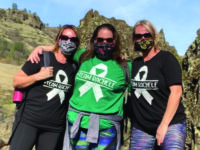The touring National Yo-Yo Contest will be held this year in Chico, to celebrate its 25th anniversary with a three day event on October 6, 7, & 8. After two years away, the best players in the country will once again wind up in the town where the contest was founded. It will be held at the Center for the Arts in Chico, which has a spacious indoor stage for the event.
How did this event start in Chico? What is the connection of Yo-Yos to Chico? Why is the National Yo-Yo Museum in Chico? The following is a brief history to help answer these questions.
In 1987, few people were thinking about yo-yos. When the folks at Bird in Hand set out to teach kids about popular children’s toys from the past, it brought about the realization that few yo-yos were actually available. Craftsmen were enlisted to design a maple wood yo-yo, and as a result, the Bird in Hand YoYo was first sold in 1988; and it was cool.
At this time, yo-yo contests were nonexistent. Bird in Hand held a pioneering contest in the spring of 1988 and a surprising number of people attended. This kicked off a blizzard of events and promotions, where people throughout California came to play yo-yos in Chico. A summer contest and a fall contest were held that same year, building more energy and awareness. Yo-Yos from other companies started to appear on shelves, including the Tom Kuhn No-Jive, the first take-apart yo-yo. A traveling exhibit entitled ‘Return of the Yo-Yo’ started in March of 1990 and spread news of Chico’s contests. It zigzagged across the country for three years.
The Chico fall contest was renamed the California State Contest in 1990. In 1993, the more widely inclusive, National Yo-Yo Contest was founded in Chico. That same year, the non-profit, National Yo-Yo Museum was created to exhibit the history of the yo-yo, and operate the National Yo-Yo Contest.
During these early contests, rules were tested, revised, and modified. In the beginning, two-yo-yo-looping tricks were the style of play. That style is now known as 2A. In 1996, the revolutionary ball-bearing-axle yo-yos were introduced and everything changed. The following year, a second division was added to the contest, the one-yo-yo-long-spin division called, 1A. Contests were soon transformed to include player created trick routines, or ‘freestyle’ performances, replacing the compulsory tricks of older contests.
By 2002, many areas of the country were requesting contests. State and Regional contests were developed and the National Yo-Yo League (NYYL) was inaugurated to direct the contests and to seed players to Nationals.
As a result of improvements to the yo-yo, and tremendous player creativity, a surge of new styles of play emerged. Three more divisions were added to the National Yo-Yo Contest in 2003. The new styles were: 3A: two-long-spin yo-yos performing string tricks, 4A: one-yo-yo unattached to the string, and 5A: one-yo-yo not-tied to the hand. For the last 15 years, these five divisions have been held in all major contests around the world and are used today.
Participation in NYYL contests has steadily increased. Kids who have picked up the sport have been expedited by readily available internet videos. Good instruction spurs kids to higher levels of skill than ever imagined. Once inspired, they dedicate themselves to a process of improvement and reward.
During the development of the modern contest structure, many issues were researched. Those who played in yo-yo contests as kids overwhelmingly could remember the outcome, especially if they were a winner. After 50 years, those who were successful carried the feeling they were ‘good at something’ into their adult lives. They learned they could be victorious when they set their minds to it.
The idea of ‘reward for effort’ was the key to moving the league forward. Awards that are given to the top players are tokens for today and an advantageous perspective for a lifetime. When hung around the necks of first, second, third places, and all the finalists, those kids who win a medal will never forget the feeling. Those who missed the finals work harder to move up in the standings.
There are several ways to play in the National Yo-Yo Contest. Finishing well in a yearly State or Regional Contest will earn a pre-qualified seeding into the preliminaries or the semi-finals. Entering the challenging wildcard round on the first day of Nationals can also earn a spot in the preliminaries.
Even with having held 25 years of contests, the NYYL has more to do. The National Contest has no age restrictions, so a 12 year old might be competing against a 24 year old. It has been noted that kids have more fun when playing against others their age, so a new yo-yo event called a ‘Futures’ contest was developed. It has five age divisions for players 18 years & under. To draw attention to this event, a Futures contest will be held in conjunction with the National Contest in Chico this year.
The National Yo-Yo Museum houses the largest public display of yo-yo history. The center piece is the World’s Largest Wood Yo-Yo at 256 lb. and 50 inches tall. Glass cases display a variety of trophies, patches, photos, and yo-yos from the 1920’s to today. Free yo-yo lessons are offered at the Museum on Saturdays 12:00-2:00 pm. Instructors from the Chico Yo-Yo Club teach all, from beginners to advanced players. This time allows players to swap tricks and motivate each other.
BY BOB MALOWNEY
Get involved!
Visit the museum; open every day with free admission.
Attend Saturday’s free yo-yo lessons.
Watch the National Contest; the best viewing is the finals on Sunday, October 8th.
For more information, check these sites: nationalyoyo.org and yoyocontest.com.






